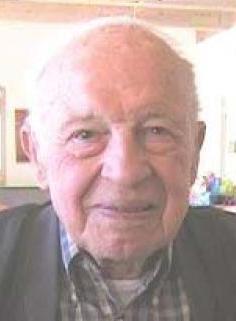
|
Director 1977 - 1990 Scholarship Chair 1977 - 1989 Leo Meyerson Rancho Mirage, CA QCWA # 1091 Chapter 154 |
World Radio founder dies at 100
By Jane Palmer - WORLD-HERALD STAFF WRITER
An early interest in amateur radio operating led to a rewarding electronics career for Leo I. Meyerson.
The Omaha native founded World Radio Laboratories in Council Bluffs in 1935 and it became one of the world's largest distributors of amateur radio equipment. Meyerson also established the World Radio electronics stores, a retail chain that operated in the Midlands from the 1950s to the 1980s.
Meyerson, known internationally by the radio call sign WØGFQ, died of complications from a stroke on Wednesday at Eisenhower Medical Center in Rancho Mirage, Calif. He had celebrated his 100th birthday on March 7.
Services will begin at 2 p.m. Sunday at Temple Israel, 7023 Cass St.
"He was just a gem of a guy and had many friends," said Dick Newsome, secretary-treasurer of the Omaha chapter of the Quarter Century Wireless Association. Members have been licensed radio operators for at least 25 years, and Newsome had known Meyerson since 1960.
He talked about their shared "marvelous hobby" we were the first 'social network,' a fraternity of people interested in radio, and how Meyerson helped start so many in the field.
"So much of the amateur radio equipment was manufactured by the big-name companies and it was very expensive," Newsome said. "Leo was very competitively priced. Not only that: He would put you on a budget plan and you made payments by the month. That's how so many amateur operators got on the air with affordable equipment."
Meyerson retired in 1977 and divided his time between the Omaha-Council Bluffs area and Palm Springs, Calif.
Troy Meyerson of Omaha, a grandson, said his grandfather built a one-tube receiver as a boy to hear the 1921 national radio broadcast of a Jack Dempsey fight on KDKA.
After graduating from Abraham Lincoln High School in the Bluffs and the University of Nebraska in Lincoln, Meyerson borrowed $1,000 from his father to start Wholesale Radio Laboratories in the 1930s. The company later became World Radio Laboratories.
At the outset of World War II the government asked Meyerson to rapidly increase production of radio crystals, and his efforts won him the Army-Navy E Award for excellence for war materials, his grandson said.
"You'd go over to Grandpa Leo's house, and he was getting off the radio from talking to someone in South America or in Australia," the grandson said. "Back then it was a big deal. He was doing this when you couldn't speak to people across the world easily, if at all. He was also very active in the public service aspect of amateur radio. He really left his mark on his hobby."
In times of disaster, when telephone communication was not available, Meyerson and other amateur radio operators volunteered to relay messages.
Meyerson was a national director for the Quarter Century Wireless Association from 1977 to 1987 and he was inducted into the organization's Hall of Fame in 1994. He was elected a fellow of the Radio Club of America in 1980 and he was a life member of the International Mission Radio Association, Wireless Pioneers and American Radio Relay League.
"He was a people person," his grandson said. "You never heard a cross word out of his mouth. Everybody was a future friend to him."
Meyerson also was an accomplished pianist and organist and considered a career in music as a college student. When he was a teen he provided musical accompaniment for silent movies at a theater in Council Bluffs.
"He loved to play the piano for his wife and for dinner parties," his grandson said. "She would sing and my grandpa would play. He could play anything by ear."
Meyerson's wife, Helen, and grandson Bruce Fellman preceded him in death. Survivors include daughter Darlynn Fellman and son Larry Meyerson, both of Omaha; six grandchildren; and 16 great-grandchildren.
Leo Meyerson, WØGFQ, is a renowned pioneer in the history of radio in the Midwest. His interest in wireless began in 1920, when after a classroom lecture in Council Bluffs about the advent of radio broadcasting stations, Leo and a friend built a one tube receiver on which they heard KDKA's first broadcast from Pittsburgh. A few years later, in 1924, with plans he found in a magazine, Leo built a small transmitter on which he broadcast music and news to neighbors. Leo was first licensed as an amateur radio operator in 1928, supporting his hobby with money earned as an organist, playing at the local theater during silent movie days.
In the mid 1930's Leo borrowed $1,000 from his father to launch Wholesale Radio Laboratories in Council Bluffs, which operated until Pearl Harbor in 1941. Leo and a friend, Al Shideler, then formed a company, Scientific Radio Products, to grind crystals for the U.S. military.
In 1943 their company won the Army-Navy E Award. After the war Leo returned his focus to WRL, which he soon renamed World Radio Laboratories, moving into manufacturing. The result was many transmitters which included the Globe Trotter, Globe Scout, Globe Chief, Globe Champion and Globe King. The company name changed to WRL Manufacturing in 1953 and to Globe Electronics in 1958, later to be sold to Textron in 1959.
Another manufacturing firm, Galaxy Electronics was formed by Leo in 1962. Its primary amateur products were the Galaxy 300, Galaxy III, Galaxy V, and GT-550 single sideband transceivers. Galaxy was sold to the Hy-Gain Antenna Company in 1970. Leo's son, Larry, became president of World Radio, which was converted into a successful consumer products company. Leo retired in 1977.
Throughout the years Leo has been very active with the public service aspect of his hobby. He is a life member of the Quarter Century Wireless Association, serving as a National Director from 1977 to 1987. In 1991 he was named the QCWA Amateur Member of the year and in 1994 he was inducted into the QCWA Hall of Fame. He is also a life member of the American Radio Relay League, Society of Wireless Pioneers, and International Mission Radio Association among other associations. In 1980 Leo was elected a fellow of the Radio Club of America, one of the most prestigious radio clubs in America.
Currently Leo spends a great deal of time with the The Leo Meyerson Radio Collection exhibit at Omaha's Western Heritage Museum. This display is one that projects a positive image of ham radio and is visited by thousands each month. It is billed as the "World's Largest Amateur Radio Exhibit." (Excerpted from Ham Hum - November 1994)
The 1997 Dayton Hamvention Amateur of the Year is Leo I. Meyerson, WØGFQ of Omaha, NE. An amateur of 69 years, WØGFQ founded World Radio Labs. Was a manufacturer of countless transmitters and receivers including the Globe Scout and the Globe King.
"When I got started in the radio business, it was 1935. I catered especially to the radio amateurs. We had what we called a WRL-70 which was our first transmitter put out in 1937. And then we were working on a 150 watt rig when the war started.
When the war was over, I went back to building transmitters and getting into the amateur business again. And I realized that there would be a pent-up demand for equipment of all sorts. We designed the Globe King and all the rest of those items which sold very well." WØGFQ
Mr. Meyerson became a member of the QCWA in 1955, and was the first chairman of the QCWA Scholarship Program.
"They put me in charge of the scholarship program, which is my baby. Something near and dear to me." WØGFQ
At 86 years young, WØGFQ, who still plays tennis, plans on being at the Hamvention Banquet to accept his award.
April 28, 1998 - Leo Meyerson Asks Help to Preserve Radio Collection
Leo Meyerson, WØGFQ, founder of World Radio Laboratories, is requesting the assistance of hams from Ak-Sar-Ben and other radio clubs interested in the preservation of the Leo Meyerson Radio Collection-an amateur radio resource of great historical and educational value to the community. The future of the collection at the Western Heritage Museum is currently in jeopardy.
In a letter dated April 28, 1998, Leo Meyerson wrote me saying:
"...I am facing a dilemma concerning the Museum. We have a new Director-Randall Hayes, a nice fellow but one who apparently does not appreciate the amateur exhibit. It does not have a high priority in his thinking.
"It would be timely if you and a group would contact him and explain how important our exhibit is to the community and the contributions made in the past to make possible what we all enjoy today. His phone number is 444-5071. Hope I am not asking too much and would like to meet you soon.
"It would be a great help to me if a committee of interested hams from Ak-Sar-Ben and other clubs could contact Randall and offer to assist him as his knowledge of amateur radio is limited. I of course could help but just celebrated my 87th birthday and won't always be around. I spent many years accumulating the collection and many amateurs around the country have helped. So the museum has a responsibility to the donors. The former Director was very pro-amateur and we need new direction from the present one. 73, Leo."
The Leo Meyerson Radio Collection is now in storage at the Western Heritage Museum in Omaha, Nebraska. This collection traces the development of amateur radio from the Lee DeForest audion tube to the growth of World Radio as a major supplier of both commercial and amateur radio components.
This collection is a combination of Mr. Meyerson's collections and items donated by hundreds of dedicated individuals. It represents the beginning of a collection that was to be incorporated into a major communications exhibit with Western Heritage Museum as the designated repository.
The museum has a collection of over 200 radios, including the 1906 Lee DeForest Vacuum Tube, Spark Transmitter, Crosley Pup, early transmitting tubes, Globe Scout, Galaxy Amateur and Commercial Single Side Band Transceivers, and many other articles of interest including early receivers such as Breting, Hammarlund, Hallicrafters, Howard, RME and National. Also included in the collection are over 1,700 items that have been placed in the museum's study collection for use by researchers. Over 5,000 receiving and transmitting tubes are also on hand. The exhibit had a working HAM station on both S.S.B. and A.M. as well as other hands-on activities for the public to enjoy.
On April 22, 1998, Terence E. Keane, Senior Curator of the Western Heritage Museum wrote:
"Three years ago [1995] the museum's Board of Trustees officially suspended all collecting and promotional efforts associated with the ham radio collection. Subsequent notices or printed materials about the collection that may have appeared were circulated without the museum's prior knowledge or approval. Other than a few radios to be included in a small exhibit on World Radio, all of the equipment is to remain in storage until its ultimate disposition is determined."
For those interested in more information on the Leo Meyerson Radio Collection and on Leo Meyerson, WØGFQ, the founder of World Radio Laboratories, it is posted on the World Wide Web at: http://www.qsl.net/kp4md/museum.htm and http://www.qsl.net/kp4md/w0gfq.htm or I can send it to you via E-mail or standard mail.
Contact information for the Museum is:Western Heritage Museum
801 South 10th Street
Omaha, NE 68108-3299
Phone (402) 444-5071 FAX (402) 444-5397
73, Charlie, KP4MD/Ø
E-mail: kp4md@qsl.net
Packet: KP4MD@WA0ZQG.#WIA.IA.USA.NA
Submission to QCWA Journal Editor
By Dick Clark, K6GLB
I was first licensed in 1954 while a junior in high school. I could ill afford radio equipment and my parents were reluctant to finance my hobby, so I was reduced to perusing the ham magazines of that era. In the advertising sections, there always appeared ads from World Radio Labs of Council Bluffs promoting their inexpensive radio transmitters. With each ad there appeared a picture of the store and the company owner, Leo Meyerson WØGFQ. These ads turned up in so many journals, magazines and handbooks during those years that his picture and name were forever etched onto the minds of anyone following this pursuit. There was never a single personality, except possibly ARRL Founder Hiram Percy Maxim, that was so associated with ham radio.
Recently I was more than surprised to learn that there was a luncheon (QCWA154) to honor Leo and award him a certificate for 80 years as a licensed amateur. I was quite surprised because, being new to the club, I had no idea Leo was still with us. I attended the luncheon along with a myriad of other hams filling the restaurant. Leo earned his license when he was 17 and today is 97. He needs someone to steady him as he walks. When he speaks, he measures his words carefully and his sense of humor and story telling skills are well intact.
Dave Bell, W6AQ licensed over 55 years, traveled from his home in Hollywood to emcee the occasion. Dave Bell is a former chairman of the ARRL's PR Committee, personal friend of Leo Meyerson and a frequent speaker at ham radio gatherings. Introducing Dave was Gene Pentecost W4IMT, QCWA Chapter 154 president. Dave asked Leo for his most memorable moment in ham radio. Leo's response exemplifies his subtle sense of humor. Paraphrasing Leo's answer, "I had this acquaintance who was traveling to Mexico City ask me for a ham referral there. I gave him the name of a friend. A week later, I called my Mexican friend and asked him if he had been contacted by my acquaintance. 'Oh! Sure' was his response, 'Do you want me to cash anymore checks for him?' I told him, hell no! And asked how much he had cashed. I sent my Mexican friend $650.00 to cover the bad checks."
Leo is such an interesting personality, especially to those of us in ham radio that I wanted to know more about his 97 years. Leo was born in Omaha in 1911 and in 1919 his family moved to Council Bluffs, Iowa just across the Missouri River east of Omaha.
Leo earned his amateur radio license W9GFQ in 1928 after a run in with the feds for unlicensed broadcasting on the AM bands for three months. When the zero call area came into being, he changed to WØGFQ. After college, Leo's father encouraged him to enter the family grocery business but after several years, Leo sought his independence and opened his first ham radio and electronics store naming it "Wholesale Radio Laboratories."
World War II curtailed the activities of ham radio forcing Leo to seek an alternative vocation. He found this by producing hundreds of thousands of quartz crystals for the military for which he received the coveted Army Navy production "E" award for achievement in producing materials for the war. After the war, Leo restarted the ham radio business under the slightly new name of "World Radio Laboratories" (WRL).
This begins what I like to term, "the golden age of amateur radio." With the technology developed during the war, numerous companies began producing very fine ham radio equipment.
Leo joined "The Rise of the Boatanchors" by hiring engineers to design transmitters for the burgeoning market. Under the "Globe" brand, World Radio Laboratories sold numerous models the best known of which was the Globe Scout that sold over 50,000 units during its lifetime. In an interview I asked about receivers. Expressing regret, Leo responded that he could never find an engineer capable of designing a receiver that he was comfortable in marketing.
Asked about his successful marketing and advertising, Leo wanted to personalize his company. Each day he went in the shipping department to sign every invoice with "Thanks, 73s, Leo WØGFQ." One of his most successful advertising ventures was the production of his US map of ham regions of which he distributed over 750,000 copies.
Conversing with Leo Meyerson is a historic walk through this golden age. He speaks affectionately of friends such as Art Collins, Bill Halligan of Hallicrafters, Robert Drake, Faust Gonset, Lloyd Hammarlund, Bob Henry, Jim Millen and National Radio engineers Fred Drake and Glen Browning. He related conversations with Herb Johnson of Swan Electronics and Edgar F. Johnson of the Viking brand. Even though many of these men were competitors, to his credit, Leo never speaks negatively of anyone. Sometimes a smile or hesitation reveals an undeclared recollection but Leo just moves on to the next subject.
More than an icon to amateur radio, Leo Meyerson is an icon to American Citizenship. Leo capitalized on the freedoms we share as Americans to build businesses, create useful products and generate employment. It is the Leo Meyersons that make this such a great country.
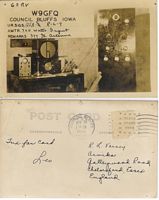
1938 QSL for QSO with G5RV
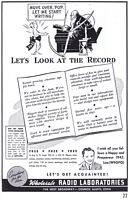
1942 QST Ad
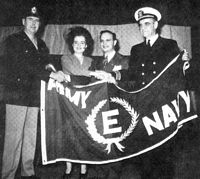
Army Navy 'E' Award Oct. 2, 1943 Pictured are representatives of the Army and Navy and accepting the award are Rose Paluka, the editor of the company newsletter
"Crystal Gazer", and Leo I. Meyerson
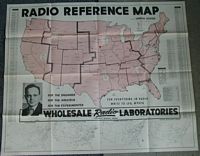
1943 Map
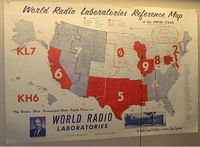
1950's Map
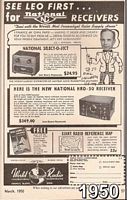
1950 Ad
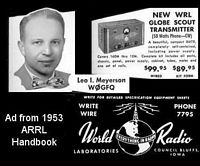
1953 Ad
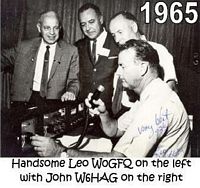
1956 with Friends
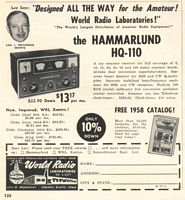
1958 Ad
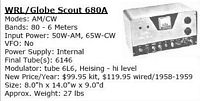
1958 Globe Scout 680A

1958 Globe Champion 300A

1958 Globe King 500C

WRL Catalog
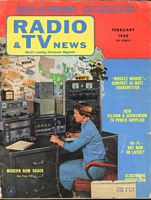
Feb 1958 - Cover

Feb 1958 - Story
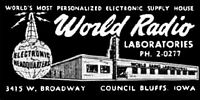
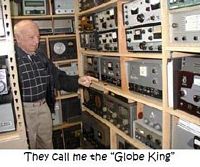
The Globe King!
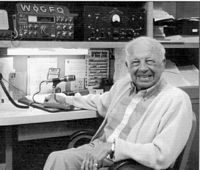
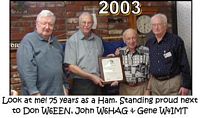
2003 with Friends
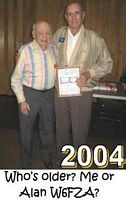
2004 with Alan, W6FZA
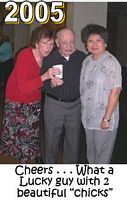
2005

2007
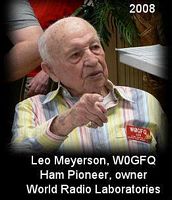
2008

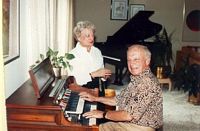
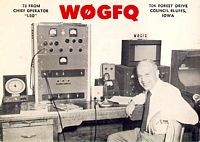
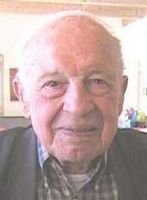
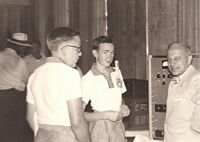
Here is a photo I have of Leo from 1956 at the Texas Hotel in Fort Worth for an AARL West Gulf Convention. The boys in the figure are my brother W5CZW and a neighbor Mike W5EOZ. We lived in Brownfield TX on the South Plains at this time. The rig shown in the photo is a WRL Globe King 500. My brother purchased that transmitter for $300 using money from his after school/weekend job. There is a WRL metal ruler sticking out of Rudy's shirt pocket. That ruler is on my desk today. I was a novice at that time, KN5BDX. My parents were also Ham's, K5GEC (SK) and W5FBM (SK). I have the K5GEC radio call on my license plates. See QRZ.com (N5XG) for more information.
Donald Simmonds N5XG
Fort Worth TX

The memories from a lot of Hams will be made public now, especially the Midwest Hams that ever ordered anything from WRL. Leo was the last of the pioneer Ham store Founders that I AM AWARE OF. Very sad to see them passing on. Dick Philstrom WØTLE
I wish condolences to Leo Meyerson's family and circle of friends with the passing of Leo. His legacy will live on along with the fondest of memories from our days of WORLD RADIO LABS. Marv, K2VHW
The amateur service has lost a giant. I can't help but think about everything Leo lived to see. Surely there are only a handful remaining on this planet who was alive at the time of the sinking of the Titanic, lived through not one but two World Wars, was alive to see Lindbergh be first to fly across the Atlantic -- not to mention having lived through almost the entire development of radio technology -- and the formation of the ARRL. What an amazing life! 73, Jeff KE9V
Besides the WRL, Globe. there were the WRL QSL cards. Also, Leo held my call, V31JP, before me. It is sad to hear of his passing and a great loss to our ham community. RIP Leo, 161, Joe, Ronnie(Rowena), Marty & Sidney Pontek, Belize (Hopkins Village) V31JP K8JP VP5/K8JP VP5JP K8JP/VA2
Very sad to see that Leo, W0GFQ has jointed SK's. Year's ago when I was attending QCWA National Conventions with my father, Leland Smith W5KL (ex W4YE ) we would often meet with Leo and his wife. What a pleasure to have known Leo. Such a fine gentleman. As a long time member of QCWA, Leo was always a strong supporter and a dedicated and enthusiastic director for many years. He also was a long time member of the QCWA scholarship committee. Hope many of you sent Leo your QSL on his 100th birthday. 73, Buddy, W4YE - (Final count, 1198 birthday qsl cards NØUF)
Bob, this is just the worse news. I am so saddened by this. Gracious. We have lost one of the greatest in our industry and as I said in my presentation at his 100th, Leo was the 'SPIRIT' of amateur radio. We will miss this spirit, Bob. Thank you for letting me know. on the way to Visalia. BOB HEIL, K9EID
Condolences to the Leo Meyerson family and friends. With the passing of Uncle Leo both his memory and legacy will live on along with the fondest of memories of WORLD RADIO LABS. Mort,WA2ARS
Article reprinted with permission - Electric Radio